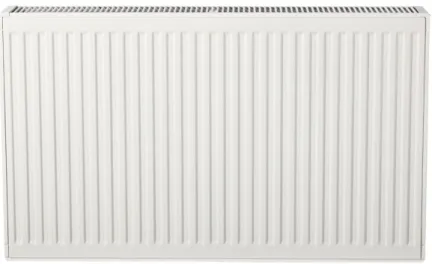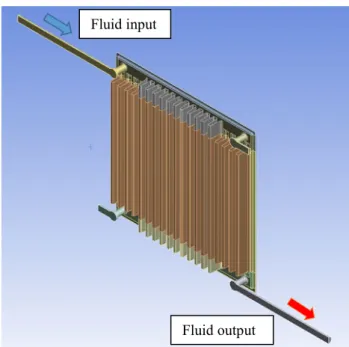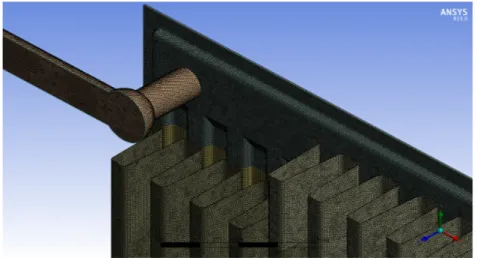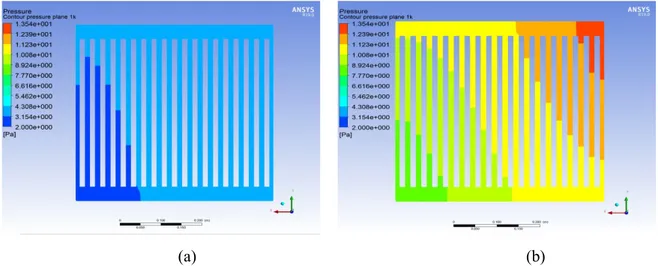Adıyaman Üniversitesi
Mühendislik Bilimleri Dergisi
12 (2020) 45-55
NUMERICAL ANALYSIS OF HEAT TRANSFER PERFORMANCE AND
THERMAL DISTRIBUTION AFFECTION OF PANEL RADIATORS TO
INVOLVING PROPYLENE GLYCOL AS INTERNAL FLUID WITH
WATER
H.Selçuk ÇELİK
1∗, Zeynep ÇELİK
2, Mehmet UÇAR
31 Osmangazi University, Mechanical Engineering, Eskişehir,26040, Turkey 2 Osmangazi University, Sivrihisar Vocational School 26600, Sivrihisar, Eskişehir 3 Vaillant Group, Turk Demirdokum Factory R&D Center, 11300, Bilecik Geliş tarihi: 13.01.2020 Kabul tarihi: 31.03.2020
ABSTRACT
Panel radiators are commonly used as heating elements with water as fluid. In this study, the different fluid is added to installation as mixed with water. Propylene glycol, which has lower freezing point value and non-toxic impression. Numerical analysises are completed by CFD method which has independence of grids to provide reasonable results. Firstly, 1x0.6 m. panel radiator which uses the 100% water as internal fluid has been analysed by numerically and then, the fluid has been changed as 10% propylene glycol and 90% water and numerical analysis has been realized under same conditions. Both scenarios have same inlet velocity as 0.0335m/s for the comparing affection of Propylene glycol involvement. When the additive is involved in the water the thermal distribution is more homogenous. However, pressure loss value is increased about 43% for the mixed fluid scenario. Eventhough, the heat transfer performance is found less about 12% than pure water. Involvement of the additive provides better thermal comfort via distribution of the homogenous heat and lower freezing point. Lower freezing point is important for living areas, which aren’t used frequently durng the winter
Keywords: Panel radiators, Heat transfer performance, Propylene glycol, Thermal distribution
PANEL RADYATÖRLERE AKIŞKAN OLARAK PROPİLEN GLİKOL
EKLENMESİNİN ISI TRANSFER PERFORMANSI VE ISIL DAĞILIMA
OLAN ETKİSİNİN SAYISAL ANALİZİ
ÖZET
Panel radyatörler günümüzde çoğunlukla su akışkanıyla birlikte kullanılmaktadır. Bu çalışmada; radyatör içeriğine suya ilave olarak, donma noktası düşüklüğü ve zehirli olmamasından dolayı belli oranda propilen glikol eklenmesinin ısı transferi ve ısıl dağılım performansına etkileri incelenmiştir. İlk senaryoda 1x0.6 m. boyutlarında olan panel radyatöre %100 su eklenerek, hücre sayısından bağımsız olarak sayısal analizler gerçekleştirilmiştir. İkinci senaryoda aynı parametreler altında, iç akışkan %90 su ve %10 propilen glikol olacak şekilde sayısal analizler gerçekleştirilmiştir. Panel radyatöre akışkan giriş hızı, her iki senaryoda aynı olmak koşuluyla 0.0335 m/s olarak tanımlanmıştır. Yapılan çalışma sonucunda, karışımlı akışkanın eklendiği panel radyatörde ısıl dağılımın daha homojen olduğu gözlenmiştir. Ayrıca, karışımlı senaryoda basınç düşüşü %43 artış gösterirken ısı transfer performansının ise saf suya göre %12 daha düşük olduğu anlaşılmıştır. Bu sonuçlara rağmen, karışımlı senaryonun ısıl dağılımın homojen olması sonucunda kullanım mahallerinde daha konforlu ısınma sunacağı ve düşük donma sıcaklığı sayesinde, kışın daimi yaşanmayan konutlar için daha kullanışlı olduğu düşünülmektedir. Anahtar Kelimeler: Panel radyatörler, Isı transfer performansı, Propilen glikol, Isıl dağılım
∗ e-posta: 1 erfolgen87@gmail.com ORCID ID https://orcid.org/0000-0003-2538-7486
2 zcelik@ogu.edu.tr ORCID ID https://orcid.org/0000-0002-3600-1027
1. Introduction
Panel radiators have been mainly preferred to heating for big areas and individual places to transfer boiler energy directly this places. efficiency of the panel radiators are so crucial for the heating system, therefore convector sequence and total heat transfer surface area affects directly transferred energy. In order to increase thermal performance and distribution, alternative fluids may be considered as additionally with water. In the solar systems ethylene glycol is commonly used like auto engines to prevent freezing during the winter. But propylene glycol is as well evaluated that is less non-toxic than ethylene glycol, however, it is more expensive but has superiorities for the human health. If the propylene glycol is added to water with ratio of 50% freezing point of the mixed fluid is -33°C. [1]
The aim of this study, testing propylene glycol as an additive with 10% ratio, with mixed water of the panel radiator, and mixed solution thermal distribution and performance has been compared with common full water 100% systems. The reason of the propylene glycol selection is, being more appropriate for human health than ethylene glycol and has same affection on decreasing the freezing point of the water which is advantageous when the home or heating area are not used throughout the winter time by the members [1].
Altuntop, made an academic study, which compares physical and thermal properties of ethylene and propylene glycol fluids. Both fluids are used to decrease freezing point of water when they are used as additive. Although both of them have same thermal properties, it is mentioned about hazardous features of ethylene glycol for the human health especially for using it in solar water heating systems, in case it combines the used-water. Due to having less non-toxic and harmful features, propylene glycol usage is recommended instead of ethylene glycol even it is more expensive. The water of the installations aren’t changed frequently unless any leakage or defect is not happened on the systems [1]. Yiven, Zishuai and the others, made a comparison between radiator varieties about thermal performance and efficiency whose types are cast-iron radiator, steel radiator and copper-aluminium radiator. Radiator sizes and flow conditions are adjusted identical and for the simulation, the software which is named as DeST-h is used. According to results, it is understood that cast iron radiator is found better than cooper aluminium type about thermal performance [2].
Embaye and the others made an academic study about investigating effect of pulse flow input on the energy for the panel radiators. A panel radiator which has 0.5 x0.3 m dimensions have been analysed by numeric method by CFD method with Comsol software, and the results show good agreement with the literature, only 2.14% deviation is found. Water inlet velocity value is increased to 0.05 m/s than 0.035 m/s with pulsed flow. These two scenarios are analysed under same conditions; it is investigated that thermal performance of pulsed flow scenario is increased about 20% than existing one. These results prove, pulse flow behaviours have good advantages for inlet fluids of the panel radiators. [3].
Yılmaz, made an analytic analysis thermal affection about using polyurethane insulation plate on the building wall where panel radiators are assembled this surface. Heating capacity is calculated for the building, when the wall in uninsulated, the heat transfer from the wall to atmosphere is calculated that 197.7 Watt energy is transferred to atmosphere from the wall, if the wall is insulated by polyurethane plates under same conditions, the heat transfer value is calculated as 75.6 Watt. In conclusion, involving on the wall the polyurethane insulation panel, the heat loss is decreased about 61.7%. It is emphasized that insulation is so crucial to sustainability of the energy resources. [4].
Kılıç and the others, made an analytical and numeric analysis on the common panel radiator in order to develop more compact, all calculations were done compatible with EN 442 and Fluent is used for CFD analysis. Consequently, about thermal performance they found 5% deviation between the results and for the both calculations, it is investigated that thermal and temperature output have good agreement with experimental data [5].
Kibar, has an academic study about panel radiator performance analysis in the mosques numerical with CFD software. It is assumed inlet temperature of the radiators 60 °C and the mosque are dimensions are 20x20 m, height is 29.5 m, the system. As a result of this study, after 1 and 1.5 hours, it is investigated that heated air is rised higher than 2 meters, therefore, it is understood that, using panel radiators are not appropriate solution for the mosques [6].
2. Material and Method
Panel radiator is firstly analysed with the pure water as ratio of 100% fluid, accordingly propylene glycol is involved the internal fluid and the results are compared.
In Figure 1, the panel radiator 1 m length and 0.6 meter height is shown. The inlet fluid temperature is adjusted 75 °C which panel radiators are so efficient under these conditions.
Figure 1. Panel radiator (1mx0.6m)
2.1. Theory
Analytic analyses are considered for the cyclindiric pipes of panel radiator as a simple view. In the numerical analyses the flow is assumed as steady state and non-compressible form. Between the first and second scenario; particularly the kinematic viscosity has difference properly due to adding propylene glycol. All the theory have crucial inputs for the numerical analysises.
𝑅𝑅𝑅𝑅 =𝑉𝑉𝐷𝐷𝜗𝜗 ℎ (1) Re, V, Dh, ϑ are the Reynolds number, velocity, hydraulic diameter and kinematic viscosity.
Reynolds number defines flow characteristic as laminar or turbulent. Based on the characteristic, Nusselt number equation is changed. When the Reynolds number is smaller than 2300 for the inlet flow, the flow region is laminar. The equation 2 is shown below. [7]
𝑁𝑁𝑁𝑁 = 1.86(𝑅𝑅𝑅𝑅 𝑃𝑃𝑃𝑃 𝐷𝐷ℎ 𝐿𝐿 )
1
Nu, Re, Pr, Di, L are Nusselt number, Reynolds number, Prandtl number, inlet diameter of the pipe and length of the pipe respectively. When the Reynolds number is between 2300 and 10000, the flow characteristic is transient and Nusselt number is found as indicated equation 3.[7]
𝑁𝑁𝑁𝑁 = 0.116 �𝑅𝑅𝑅𝑅23− 125� 𝑃𝑃𝑃𝑃13 (3)
When the Reynolds number is bigger than 10.000 the characteristic is turbulent flow, Nusselt number is found as indicated equation 4.
𝑁𝑁𝑁𝑁 = 0.023𝑅𝑅𝑅𝑅0.8𝑃𝑃𝑃𝑃𝑛𝑛 (4) ‘’n’’ is a number which is assumed related with temperature of the fluid is increased or decreased. If the temperature is increased n=0.4, if the temperature is decreased n=0.3. [7]
The friction factor (f) is found in purpose of analysing inlet flow pressure loss. But the formula is changed based on the flow characteristics. The equations are shown as follows.[7]
𝑓𝑓 =𝑅𝑅𝑅𝑅 64 (5) 𝑓𝑓 = 0.3164𝑅𝑅𝑅𝑅−14 (2300 < 𝑅𝑅𝑅𝑅 < 105 ) (6) 𝑓𝑓 = 0.0032 + 0.221𝑅𝑅𝑅𝑅−0,237 (105 < 𝑅𝑅𝑅𝑅 < 108 ) (7) The equation 5 is used when the flow is laminar which means Reynolds number is smaller than 2300, Equation 6 is used when the flow is transient, and equation 7 is used when the flow is turbulent. Pressure drop down during the flow is calculated the formula as shown equation 8. [7]
∆𝑃𝑃 = 𝑓𝑓𝐷𝐷 𝜌𝜌𝐿𝐿 𝑉𝑉𝑉𝑉2 (8) 2 ∆P, f , L, D, ρ, Vm is pressure loss, friction factor, length of the pipe, diameter of the pipe, density of the fluid and average velocity of the fluid. Related with difference inlet and outlet pressure of the fluid.
In the defined radiator the flow is sustained in the cyclindiric circular pipes. The numerical analysises are verified by continuity, energy and momentum equations.
The flow is simplified in the circular pipes of the panel radiators under cyclindiric coordinates. The continuity equation in the radiators is indicated in the equation 9 as follows.[7]
1 𝑃𝑃 𝜕𝜕(𝑃𝑃𝑈𝑈𝑟𝑟) 𝜕𝜕𝑃𝑃 + 1 𝑃𝑃 𝜕𝜕(𝑈𝑈𝜃𝜃) 𝜕𝜕𝜕𝜕 + 𝜕𝜕(𝑈𝑈𝑧𝑧) 𝜕𝜕𝜕𝜕 = 0 (9) In the equation, U is the velocity and subscripts refer to direction of the r, θ, z coordinates.
1 𝑃𝑃 𝜕𝜕 𝜕𝜕𝑃𝑃 �𝑘𝑘𝑃𝑃 𝜕𝜕𝜕𝜕 𝜕𝜕𝑃𝑃� + 1 𝑃𝑃² 𝜕𝜕 𝜕𝜕𝜕𝜕 �𝑘𝑘 𝜕𝜕𝜕𝜕 𝜕𝜕𝜕𝜕� + 𝜕𝜕 𝜕𝜕𝜕𝜕 �𝑘𝑘 𝜕𝜕𝜕𝜕 𝜕𝜕𝜕𝜕� + 𝑞𝑞′ = 𝜌𝜌𝑐𝑐𝑝𝑝 𝑑𝑑𝜕𝜕 𝑑𝑑𝑑𝑑 (10) The momentum equation is derived for the each directional coordinates of r, θ, z coordinates in the equation 11,12 and 13 as follows. In the equation 11, the momentum conservation equation is presented for ‘’r direction’’ as the incompressible fluid assumption.
𝜌𝜌 �𝜕𝜕𝑈𝑈𝜕𝜕𝑑𝑑 + 𝑈𝑈𝑟𝑟 𝑟𝑟𝜕𝜕𝑈𝑈𝜕𝜕𝑃𝑃 +𝑟𝑟 𝑈𝑈𝑃𝑃𝜃𝜃𝜕𝜕𝑈𝑈𝜕𝜕𝜕𝜕 −𝑟𝑟 𝑈𝑈𝜃𝜃 2 𝑃𝑃 + 𝑈𝑈𝑧𝑧 𝜕𝜕𝑈𝑈𝑟𝑟 𝜕𝜕𝜕𝜕 � = −𝜕𝜕𝑃𝑃𝜕𝜕𝑃𝑃 + 𝜌𝜌𝑔𝑔𝜃𝜃+ 𝜇𝜇 �1𝑃𝑃𝜕𝜕𝑃𝑃 �𝑃𝑃𝜕𝜕 𝜕𝜕𝑈𝑈𝜕𝜕𝑃𝑃 � −𝜃𝜃 𝑈𝑈𝑃𝑃𝜃𝜃2 −𝑃𝑃12𝜕𝜕 2𝑈𝑈 𝜃𝜃 𝜕𝜕𝜕𝜕2 − 2 𝑃𝑃2 𝜕𝜕𝑈𝑈𝑟𝑟 𝜕𝜕𝜕𝜕 + 𝜕𝜕2𝑈𝑈 𝜃𝜃 𝜕𝜕𝜕𝜕2 � (11) In the equation 12, the momentum conservation equation is presented for ‘’ θ direction’’ as the incompressible fluid assumption.
𝜌𝜌 �𝜕𝜕𝑈𝑈𝜕𝜕𝑑𝑑 + 𝑈𝑈𝑟𝑟 𝑟𝑟𝜕𝜕𝑈𝑈𝜕𝜕𝑃𝑃 +𝑟𝑟 𝑈𝑈𝑃𝑃𝜃𝜃𝜕𝜕𝑈𝑈𝜕𝜕𝜕𝜕 −𝑟𝑟 𝑈𝑈𝜃𝜃 2 𝑃𝑃 + 𝑈𝑈𝑧𝑧 𝜕𝜕𝑈𝑈𝑟𝑟 𝜕𝜕𝜕𝜕 � = −𝜕𝜕𝑃𝑃𝜕𝜕𝑃𝑃 + 𝜌𝜌𝑔𝑔𝜃𝜃+ 𝜇𝜇 �1𝑃𝑃𝜕𝜕𝑃𝑃 �𝑃𝑃𝜕𝜕 𝜕𝜕𝑈𝑈𝜕𝜕𝑃𝑃 � −𝜃𝜃 𝑈𝑈𝑃𝑃𝜃𝜃2 −𝑃𝑃12𝜕𝜕 2𝑈𝑈 𝜃𝜃 𝜕𝜕𝜕𝜕2 − 2 𝑃𝑃2 𝜕𝜕𝑈𝑈𝑟𝑟 𝜕𝜕𝜕𝜕 + 𝜕𝜕2𝑈𝑈 𝜃𝜃 𝜕𝜕𝜕𝜕2 � (12) In the equation 13, the momentum conservation equation is presented for ‘’ z direction’’ as the incompressible fluid assumption.
�𝜕𝜕𝑈𝑈𝜕𝜕𝑑𝑑 + 𝑈𝑈𝑧𝑧 𝑟𝑟𝜕𝜕𝑈𝑈𝜕𝜕𝑃𝑃 +𝑧𝑧 𝑈𝑈𝑃𝑃𝜃𝜃𝜕𝜕𝑈𝑈𝜕𝜕𝜕𝜕 + 𝑈𝑈𝑧𝑧 𝑧𝑧𝜕𝜕𝑈𝑈𝜕𝜕𝜕𝜕 �𝑧𝑧 = −𝜕𝜕𝑃𝑃𝜕𝜕𝑃𝑃 + 𝜌𝜌𝑔𝑔𝑧𝑧+ 𝜇𝜇 �1𝑃𝑃𝜕𝜕𝑃𝑃 �𝑃𝑃𝜕𝜕 𝜕𝜕𝑈𝑈𝜕𝜕𝑃𝑃 � −𝑧𝑧 𝑃𝑃12 𝜕𝜕2𝑈𝑈 𝑧𝑧 𝜕𝜕𝜕𝜕2 − 1 𝑃𝑃2 𝜕𝜕2𝑈𝑈 𝑧𝑧 𝜕𝜕𝜕𝜕2 + 𝜕𝜕2𝑈𝑈 𝑧𝑧 𝜕𝜕𝜕𝜕2� (13) In the equation 11,12 and 13; U,P,ρ, μ and g refers; velocity, pressure, density, dynamic viscosity and gravity values of the fluids for the each coordinates, which are expressed as subscripts.
2.2. Numerical Anaylsis Method
Water and propylene glycol physical and thermal properties are shown in Table 1. All data are defined for the numerical analysis definition. Mixed fluid properties are calculated by interpolation based on the ratios.
Table 1. Physical and thermal properties of water and propylene glycol.[8] Material (kg /m³) σ (J/kgK) cp (W/mkf2K) (Kg/ms) μ H2O 977.8 4189.5 0.6663 0.000404 C3H8O2 1040 2533 0.2006 0.0058336 90%H2O+10%C3H8O2 983.002 4023.85 0.596 0.004035 Panel -DC01 2700 505 16 - Convector -DC01 2700 505 16 -
For the both scenarios, analysis made under the same conditions due to make the optimum comparison. Both fluids temperature and velocity inlet parameters are indicated in Table 2. Values are identical.
Table 2. Fluids temperature and velocity values
Fluids Ti(°C) Vinlet (m/s)
100% H2O 75 0.0335
90% H2O +10% C3H8O2 75 0.0335
The Numerical analysis boundary conditions are shown in Table 3, all of the parameters are identical for both scenarios. Panel radiators are located same geometry and located 20 °C constant temperature ambient conditions. The viscos method is selected as realizable k- ε model as a result of having superiority for the spinned and opposite pressurized gradients. [9] Mesh optimization was performed, and the results are checked whether the mass flow is identical or not to validate the method and findings.
Table 3. Boundry conditions of numeric model
Model Adjustments
Type 3D
Time Steady state
Viscos Realizable k- ε model
Heat Transfer Enabled
Freezing or Melting Disabled
Radiation Disabled
For the both scenarios, the same model is used because only changing the fluid characteristics. In Figure 2, the model is indicated. Inlet and outlet pipes are enlarged due to providing rather homogenous fluids of the mixture.
Figure 2. Panel radiator model and fluid input and output points
The numerical analysis must have independence from grid quantities in purpose of providing stable results which have good agreement with real circumstances. Therefore, mesh quantity is defined for the both scenarios based on water outlet temperature. In Figure 3, mesh optimization is shown. As it is seen, within 20 million mesh quantity till 25 million, water outlet temperature of the panel radiator is found same value. It proves at least mesh quantity should be 20 million. Consequently, 21 million mesh quantity is defined for both scenarios to make homogenous solution with optimum solution time for the most convenient comparison.
Figure 3. Mesh quantity definition
After ensuring results of the analysis are not related with grid quantity. Grid structure is created and implemented as indicated Figure 4.
Fluid input
Figure 4. Grid structure of the model
The CFD analysis is completed for both scenarios under same condition and parameters. Velocity, Pressure and Temperature contours are compared for both scenarios. Fluid thermo-physical properties are different, therefore it is expected to find pressure contours difference and focus on temperature contours modifications in order to understand propylene glycol impression on heat distribution. All solution limitations are adjusted to same values to investigate differences obviously via colours. Velocity contours under same limits, for both scenario are shown in Figure 5.
(a) (b)
Figure 5. Velocity contours: a. 100% Water fluid, b. 90% Water +10% Propylene glycol fluid Based on the velocity distributions, major affection couldn’t be investigated which comes from the additive utilisation. Pressure contours under the same limits, for both scenarios, are shown in Figure 6.
(a) (b)
Figure 6. Pressure contours: a. 100% Water fluid, b. 90% Water +10% Propylene glycol fluid Based on the results about the pressure contours, It is investigated pressure of the fluid is increased with additive affection. Pressure loss between, inlet and outlet fluids are variable. It is supposed, this difference may be come from flow characteristics change of the fluids, because of changing viscosity change by additive.
Temperature contours under same limits, for both scenarios are shown in Figure 7.
(a) (b)
Figure 7. Temperature contours: a. 100% Water, b. 90% Water +10% Propylene glycol fluid It is found that the temperature of the fluid is more homogenous for the channel pipes due to additive affection. even, it is added only 10% ratio, panel surface has nearly same temperature distribution is more superior than pure water fluid under identical conditions. but this issue doesn’t depend on heat transfer performance like outlet temperatures of fluids.
3. Conclusions and Suggestions
Numerical analysis are realized by Fluent software for both scenarios. The affection of the propylene glycol has been researched and investigated with pros and cons. Even, it is added with 10% ratio of all mixture, the difference is noticed easily from pressure and temperature contours. Values are indicated in Table 4.
Table 4. The results of the numerical analysis for both scenarios
Mixture Concentration ΔP (Pa) Ti (K) To (K) q’’ (W/m²)
100%H2O 6.16 348.0 341.098 752
90%H2O+10%C3H8O2 8.81 348.0 341.897 638
It was found out when the additive is involved the water pressure loss is increased about 43% This change may come from viscosity significant difference between the fluids. Heat transfer performance of pure water is more about 12% than the mixed version. However, by additive both freezing point is decreased, and heat distribution is more homogenous than pure water that is investigated from thermal contours. The main reason of the thermal performance loss may be having less thermal conductivity of the additive than water. In conclusion, alternative fluids which are non-toxic and have more thermal conductivity than water may be performed and evaluated by their utilisation for these sort of systems. Even, heat transfer performance loss may be neglected due to having homogenous thermal distribution and decreasing freezing point for the domestic internally heating systems. By this additives, radiators can present more comfortable heating and the fluid makes the installation more safe for the freezing , when the owners leave it temporarily during the winter. These alternative additives should be researched to increasing both performance and life time of the installation with appliances. The scenarios will be extended about mixing ratio of fluids for the next studies in purpose of analysing parametric values widely.
Acknowledgements
Specially thanks for the support; all simulation efforts of this research; are completed by Vaillant Group R&D Center.
References
[1] Altuntaş, N., ‘‘Guneş Enerjisi Tesisatlarında Antifriz Olarak Etilen ve Propilen Glikol Kullanımının İncelenmesi’’ Tesisat Mühendisliği Dergisi, 86 (2005): p.31-38.
[2] Yiven, J., Zishuai Y., Zhaohui L., Yi, L., Rui, L., ‘‘Simulation Study of Impacts of Radiator Selection on Indoor Thermal Environment and Energy Consumption’’ 8th International Cold Climate HVAC 2015 Conference, 146 (2016): p.466-472.
[3] Embaye, M., Al-Dadah, R., Mahmoud, S., ‘‘The effect of flow pulsation on the heating performance of panel radiators in central heating systems: CFD analysis’’ Advanced Computational Methods and Experiments in Heat Transfer, 83(2014): p.27-36.
[4] Yılmaz E., ‘‘Exterior surface insulated panel radiator and energy efficiency analysis’’ International Advanced Researches and Engineering Journal, 01(2017): p.18-20
[5] Kılıç M., Mutlu M., ‘‘ Three-Dimensional Numerical Analysis of Thermal Output of a Steel Panel Radiator’’ Progress in Exergy, Energy, and the Environment, 55 (2014): p.585-593
[6] Kibar A., ‘‘A Numerical Investigation of The Heating of A 3D Mosque Model Using Panel Radiators”, Sigma Journal of Engineering and Natural Sciences, 36(2018): p.1-10.
[7] Çelik H.S., Uçar M., Erbay L.B., ‘‘Efficiency Affection Of Involving Finned Turbulators With Eliptical Formed Holes To Pipe Inlet Surfaces Of A Gas Water Heater Heat Exchanger”, 14. Ulusal Tesisat Mühendisliği Kongresi p.1149-1167, İzmir
[8] Internet: www.engineeringtoolbox.com.
[9] E. Aydar, I. Ekmekci, “Thermal Efficiency Estimation of the Panel Type Radiators with CFD Analysis,”J. of Thermal Science and Technology, 32 (2012): p. 63-71.
[10] J.A. Myhren, S. Holmberg, “Design considerations with ventilation radiators: Comparisons to traditional two-panel radiators,” Energy and Buildings, 41 (2009), p. 92-100.
[11] M. Maivel, M. Konzelmann, J. Kurnitski, “Energy performance of radiators with parallel and serial connected panels,” Energy and Buildings, 86 (2015), p. 745-753.
[12] J.D. Posner, C.R. Buchanan, D. Dunn-Rankin, “Measurement and prediction of indoor air flow in a model room,” Energy and Buildings, 35 (2003), p. 515-526.
[13] X. Cao, J. Liu, N. Jiang, Q. Chen, “Particle Image Velocimetry measurement of indoor airflow field: A review of the technologies and applications,’’ Energy and Buildings, 69 (2014), p. 367-380.
[14] Beck, S.M.B., Grinsted, S.C., Blakey, S.G. and Worden, K., ‘‘Novel design for panel radiators.’’ Applied Thermal Engineering, 24 (2004), p. 1291–1300.
[15] Khaled, A.R.A., ‘‘Heat transfer enhancement due to properly managing the distribution of the heat flux.’’ Energy Conversion and Management, 53 (2012), p.247-258.
[16] Chen, Y. and Zhao, J., ‘‘Applications of the Strong Heat Transformation by pulse flow in the Shell and tube heat exchanger.’’ HVAC Technologies for Energy Efficiency, 06 (2006): p. 11-105.
[17] Dineen, D. and Gallachoir, B.P.O., ‘‘Modelling the impacts of building regulations and a property bubble on residential space and water heating.’’ Energy Buildings, 43(2011): p. 166-178. [18] Myhren, J. A. and Holmberg, S., ‘‘Flow patterns and thermal comfort in a room with panel, floor

![Table 1. Physical and thermal properties of water and propylene glycol.[8] Material (kg /m³) σ (J/kgK) cp (W/mkf 2 K) (Kg/ms) μ H 2 O 977.8 4189.5 0.6663 0.000404 C 3 H 8 O 2 1040 2533 0.2006 0.0058336 90%H 2 O+10%C 3 H 8 O 2 983.002 4023.8](https://thumb-eu.123doks.com/thumbv2/9libnet/4494616.79126/6.892.163.730.157.338/table-physical-thermal-properties-water-propylene-glycol-material.webp)



